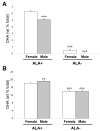Gender differences in rat erythrocyte and brain docosahexaenoic acid composition: role of ovarian hormones and dietary omega-3 fatty acid composition
- PMID: 19046819
- PMCID: PMC2692269
- DOI: 10.1016/j.psyneuen.2008.10.013
Gender differences in rat erythrocyte and brain docosahexaenoic acid composition: role of ovarian hormones and dietary omega-3 fatty acid composition
Abstract
The two-fold higher prevalence rate of major depression in females may involve vulnerability to omega-3 fatty acid deficiency secondary to a dysregulation in ovarian hormones. However, the role of ovarian hormones in the regulation of brain omega-3 fatty acid composition has not been directly evaluated. Here we determined erythrocyte and regional brain docosahexaenoic acid (DHA, 22:6n-3) composition in intact male and female rats, and in chronically ovariectomized (OVX) rats with or without cyclic estradiol treatment (2 microg/4d). All groups were maintained on diets with or without the DHA precursor alpha-linolenic acid (ALA, 18:3n-3). We report that both male (-21%) and OVX (-19%) rats on ALA+ diet exhibited significantly lower erythrocyte DHA composition relative to female controls. Females on ALA+ diet exhibited lower DHA composition in the prefrontal cortex (PFC) relative males (-5%). OVX rats on ALA+ diet exhibited significantly lower DHA composition in the hippocampus (-6%), but not in the PFC, hypothalamus, or midbrain. Lower erythrocyte and hippocampus DHA composition in OVX rats was not prevented by estrogen replacement. All groups maintained on ALA- diet exhibited significantly lower erythrocyte and regional brain DHA composition relative to groups on ALA+ diet, and these reductions were greater in males but not in OVX rats. These preclinical data corroborate clinical evidence for gender differences in peripheral DHA composition (female>male), demonstrate gender differences in PFC DHA composition (male>female), and support a link between ovarian hormones and erythrocyte and region-specific brain DHA composition.
Figures




Similar articles
-
Omega-3 fatty acid deficiency during perinatal development increases serotonin turnover in the prefrontal cortex and decreases midbrain tryptophan hydroxylase-2 expression in adult female rats: dissociation from estrogenic effects.J Psychiatr Res. 2009 Mar;43(6):656-63. doi: 10.1016/j.jpsychires.2008.09.011. Epub 2008 Nov 4. J Psychiatr Res. 2009. PMID: 18986658 Free PMC article.
-
Chronic risperidone treatment preferentially increases rat erythrocyte and prefrontal cortex omega-3 fatty acid composition: evidence for augmented biosynthesis.Schizophr Res. 2009 Feb;107(2-3):150-7. doi: 10.1016/j.schres.2008.09.027. Epub 2008 Nov 7. Schizophr Res. 2009. PMID: 18993032 Free PMC article.
-
Specific brain regions of female rats are differentially depleted of docosahexaenoic acid by reproductive activity and an (n-3) fatty acid-deficient diet.J Nutr. 2007 Jan;137(1):130-4. doi: 10.1093/jn/137.1.130. J Nutr. 2007. PMID: 17182813
-
Docosahexaenoic acid (DHA): an ancient nutrient for the modern human brain.Nutrients. 2011 May;3(5):529-54. doi: 10.3390/nu3050529. Epub 2011 May 10. Nutrients. 2011. PMID: 22254110 Free PMC article. Review.
-
Metabolism and functional effects of plant-derived omega-3 fatty acids in humans.Prog Lipid Res. 2016 Oct;64:30-56. doi: 10.1016/j.plipres.2016.07.002. Epub 2016 Aug 3. Prog Lipid Res. 2016. PMID: 27496755 Review.
Cited by
-
Estrogen Interactions With Lipid Rafts Related to Neuroprotection. Impact of Brain Ageing and Menopause.Front Neurosci. 2018 Mar 6;12:128. doi: 10.3389/fnins.2018.00128. eCollection 2018. Front Neurosci. 2018. PMID: 29559883 Free PMC article. Review.
-
Reduced expression of fatty acid biosynthesis genes in the prefrontal cortex of patients with major depressive disorder.J Affect Disord. 2011 Mar;129(1-3):359-63. doi: 10.1016/j.jad.2010.08.021. Epub 2010 Sep 21. J Affect Disord. 2011. PMID: 20863572 Free PMC article.
-
Omega-3 fatty acid deficiency augments risperidone-induced hepatic steatosis in rats: positive association with stearoyl-CoA desaturase.Pharmacol Res. 2012 Oct;66(4):283-91. doi: 10.1016/j.phrs.2012.06.010. Epub 2012 Jun 29. Pharmacol Res. 2012. PMID: 22750665 Free PMC article.
-
Adult medication-free schizophrenic patients exhibit long-chain omega-3 Fatty Acid deficiency: implications for cardiovascular disease risk.Cardiovasc Psychiatry Neurol. 2013;2013:796462. doi: 10.1155/2013/796462. Epub 2013 Feb 27. Cardiovasc Psychiatry Neurol. 2013. PMID: 23533712 Free PMC article.
-
Perinatal Dietary Polyunsaturated Fatty Acids in Brain Development, Role in Neurodevelopmental Disorders.Nutrients. 2021 Apr 2;13(4):1185. doi: 10.3390/nu13041185. Nutrients. 2021. PMID: 33918517 Free PMC article. Review.
References
-
- Asarian L, Geary N. Cyclic estradiol treatment normalizes body weight and restores physiological patterns of spontaneous feeding and sexual receptivity in ovariectomized rats. Horm Behav. 2002;42:461–471. - PubMed
-
- Bakewell L, Burdge GC, Calder PC. Polyunsaturated fatty acid concentrations in young men and women consuming their habitual diets. Br J Nutr. 2006;96:93–99. - PubMed
-
- Becker JB, Arnold AP, Berkley KJ, Blaustein JD, Eckel LA, Hampson E, Herman JP, Marts S, Sadee W, Steiner M, Taylor J, Young E. Strategies and methods for research on sex differences in brain and behavior. Endocrinology. 2005;146:1650–1673. - PubMed
-
- Bourre JM, Dumont OS, Piciotti MJ, Pascal GA, Durand GA. Dietary alpha-linolenic acid deficiency in adult rats for 7 months does not alter brain docosahexaenoic acid content, in contrast to liver, heart and testes. Biochim Biophys Acta. 1992;1124:119–122. - PubMed
-
- Burdge GC, Jones AE, Wootton SA. Eicosapentaenoic and docosapentaenoic acids are the principal products of alpha-linolenic acid metabolism in young men. Br J Nutr. 2002;88:355–363. - PubMed
Publication types
MeSH terms
Substances
Grants and funding
LinkOut - more resources
Full Text Sources
Miscellaneous

